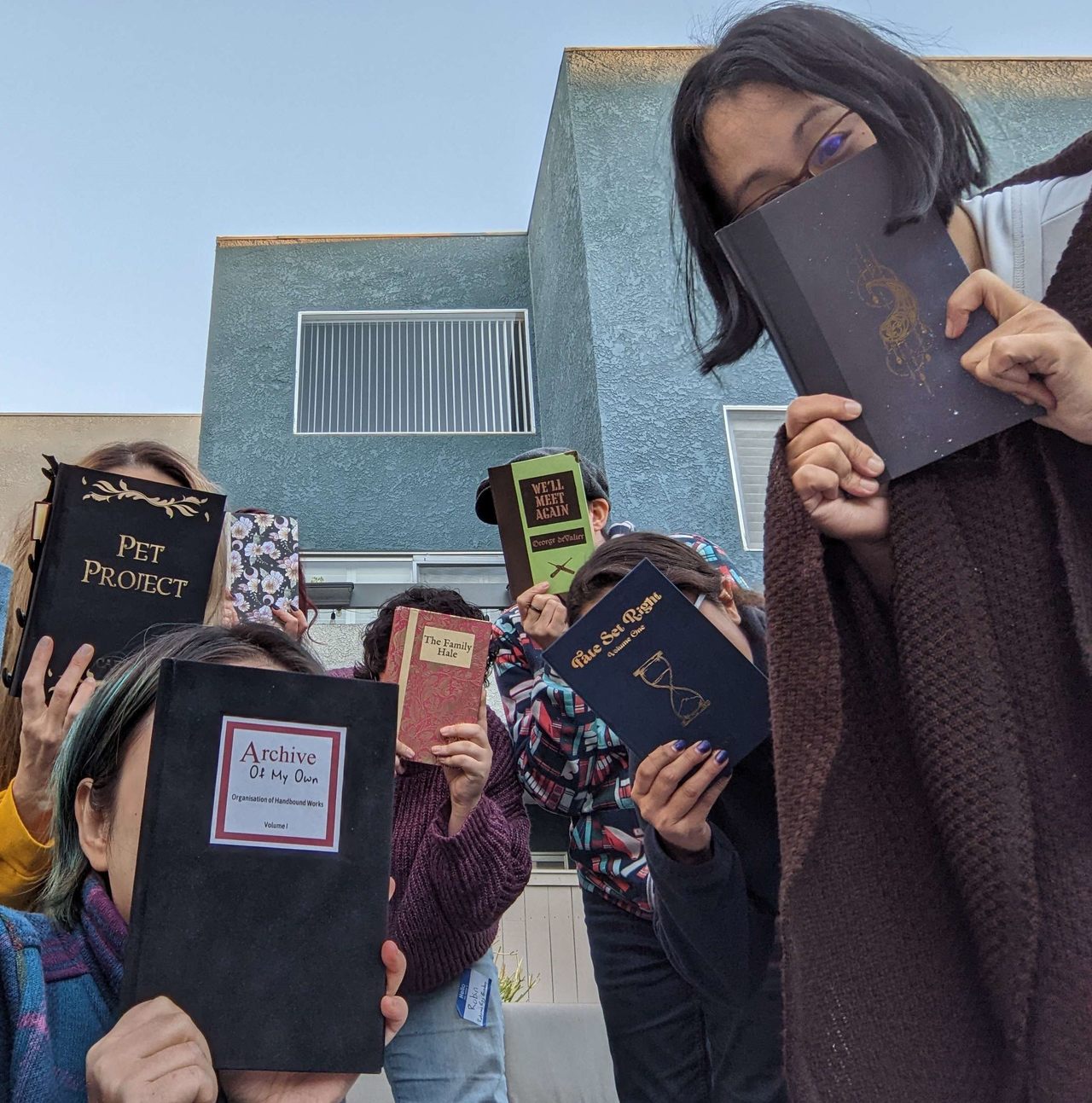The Emerging Art of ‘Fanbinding’
Fanfiction enthusiasts are learning “1,000 hobbies in a trench coat” to make gorgeous physical artifacts of their passions.

The idea first came to Tiffo while they were volunteering at a local nonprofit writers’ league. In addition to that, they’d been active in online fanfiction communities for years, cheering on fellow writers who published their work digitally, sometimes at novel-length (or longer!), entirely for free. Members of both groups of writers were always excited to share their work with the world—but there was one key difference. “People I knew from the writers’ league got to walk up and go, ‘Look at my book,’” Tiffo says. “I got to hand it to them and say, ‘Sign your book for me.’ It’s beautiful to have that moment, to get to see the things that people worked so hard on become a physical thing.” And then they thought: Fanfiction authors work just as hard on their stories as any other kind of writer. Why couldn’t they have that same experience?
Tiffo looked up bookbinding tutorials to create their first physical fanfic artifact: a pair of anthologies of their best friend’s Doctor Who stories. (Since their friend often wrote about the character Rose, Tiffo even cross-stitched a galaxy-patterned rose for one of the covers, probably the last time they’ll cross-stitch for a book, they joke. But you never know.) They fell in love with the act of physically making books, but felt certain they couldn’t be the only one excited by the idea of binding fanfiction specifically. The internet was there to help: They found the term “fanbinding”—and, more importantly, the Renegade Bindery.


Renegade is a collective that grew from a post by a fan named ArmoredSuperHeavy, who’d been sharing fanbinding resources on Tumblr since 2016. Part guide, part manifesto, he wrote: “I bind fanfic and other underground writing into real books. I am a Guerrilla publisher.” In 2020, the Renegade Discord server was created, attracting a few dozen fans who were interested in learning to bind together. When Tiffo joined a year later, it had around 300 active members; today, there are nearly 3,000.
“The rebel concept of it really struck me,” says Desmothene, who learned about fanbinding via Tumblr. “While my family knows I read fanfic, I would still get asked, ‘Why don’t you read/write a real book?’ and you know what, here was my opportunity to turn fanfiction into a real book.” Using the communal resources on Renegade, Des learned the practice, and learned it well; under the name Celestial Sphere Press, she focuses on “on fics that I return to, over and over. There are certain authors that I really just want to put everything they’ve ever written on my shelf—the comfort reads, the fics that made me cry, the fics that if they disappeared from the internet, I’d be devastated.”
Pipsqueak, aka Butterfingers Binding, initially joined Renegade to find someone she could hire to bind a friend’s fic—but when she saw the group had “the same interest in figuring out how this book thing worked,” she realized she could try it herself, even though she didn’t think of herself as particularly artistic. “People were actively trying out different ways to do things, going out of their way to share tips and tricks to help people get started on a budget, and just enjoying themselves and interacting with others,” Pip says. “That’s the main reason I picked up fanbinding—I found this to be the first fannish community I’d been in that was happy to discover things together. This helped me gain the confidence to think, ‘Actually, maybe I can do this’—and I did!”
Like all bookbinding, fanbinding begins with the text. When you select a story, you typeset it, making decisions about things like font, spacing, and drop-caps, and deciding whether to include art or other visual flourishes. Some typesetting software formats a manuscript for book printing, known as imposition; Renegade has an imposer on GitHub to convert a basic PDF to a format suited to be bound. When the pages are printed, you fold them and sew them all together, creating a “text block,” and the sewn blocks of pages are then glued to the spine of the case, along with things such as endpages and headbands—the little sewn bit at the top and bottom of the spine. Design choices beyond that are wholly up to the binder: deckled page edges, complicated cut-outs, anything from simply displaying the title and author to creating an elaborate work of art for a cover or title page.
There’s a strong parallel between the amateur, instinctive nature of fanfiction and the act of fanbinding. While plenty of fic is penned by formally trained writers, much of it is not. Tiffo, who binds as Fanboundbooks, likens the reverse-engineering involved in teaching oneself both activities. As writers, people try to figure out why stories work. Fanbinders collectively share the process of learning to turn that work into a physical object—tactile, clean, often beautiful. Fic is largely unencumbered by the forms and structures of traditional publishing, and fanbinders approach their work with the same spirit. “People will often say, ‘How do I do this?’ or ‘What’s the rule for this?’” Tiffo says. “The answer that we always try to throw in Renegade is, ‘This is what other people have done, but know that there is no rule to your book—you can make whatever you want.’”



The result is a huge range of books, often one-of-a-kind, from simple sewn hardbacks to elaborate works of art, some of which are in direct conversation with the fic itself, or the fic’s source material. “I recently bound a Witcher fic, set in Kaer Morhen during the winter, that featured a cerulean blue jacket, so it’s bound in a blue to match, with blue drop caps in a middle ages–style font alongside woodcut prints of wolf cubs playing,” says Des. For a Mo Dao Zu Shi fic (based on the popular Chinese novel and telelvision series), she made hexagrams from the text of the I Ching; for a Star Wars fic, she played with the aesthetics of Jedi temples. Renegade’s servers are full of inspiration and feedback about design choices, from typesetting to covers, and they even literally share materials, buying paper and cloth in bulk and sending portions of it to compatriots around the world.
The collective also hosts workshops, crafting sessions, events, and even an in-person retreat. In February 2024, they celebrated Binderary, an event inspired by month-long creative challenges such as NaNoWriMo or Inktober, but with lower stakes and individual goals, such as learning a new binding technique. This year, a Binderary-specific server had 600 members, and the event included volunteer-run classes that were free and open to everyone. “For years, bookbinding was considered a dying art, or only accessible to professionals,” says Pip, who helps run Binderary events and is the lead server moderator. She cites a class, “Who Needs Tools Anyway?” on binding with everyday items. “You don’t need a ton of fancy tools or supplies, especially to start out. Heck, my first book was made with cereal boxes as a board, scrap curtain fabric for cloth, and fishing line. I still prefer using fishing line to sew it—much to everyone’s horror!”
This DIY spirit aligns with Renegade’s commitment to the fannish gift economy, the ethos that underpins the largely non-monetized fanfic world. Renegade’s members don’t charge money for their labor, though they might ask a recipient to help with material costs. Des helped write these values into the Code of Conduct, which members agree to when they join the Renegade Bookbinding Guild. Binders generally get permission from the authors whose fic they’re binding, and that mutual respect extends to keeping binding free. “We are here because we were inspired by the work of these authors, and in my opinion to turn around and monetize what they gifted us for free is a betrayal,” Des says. “For-profit binding also increases the perception of fanfiction as a commodity rather than a form of community participation, putting pressure on authors to generate content for the readers’ consumption. That’s the opposite effect that we want to have.”
Even though many fanbinders today are relatively new to the practice, the act of binding fanfic stretches back decades: Prior to the web, fic was almost wholly read in zines, printed and bound at collating parties, and distributed by mail or at conventions, where it was often sold under the table (for legal reasons). The internet led to an explosion in fanfic writing and reading, at least in part because the practice was no longer limited to the finite page space of zines. Three decades later, the rise of fanbinding seems to speak to the limits of a digital-only medium, despite its infinite space and universal distribution.

“When most of the books you own are e-books, then you want the physical ones to be special,” says Des. “But the digital-only presence is starting to create more anxiety, too, as people realize the games and books and movies they own through an online service can be deleted or removed without much effort. You can’t delete a physical book out of my hands.” Pip also thinks of the practice as an archival one, citing LiveJournal’s 2007 Strikethrough and Tumblr’s 2018 adult content ban as moments when fandom history was erased from the web. “With all the uncertainty happening at the moment in various countries, there’s a risk that works by queer and minority authors may start being erased,” she says. “This is ensuring another way for them to live on.”
That materiality is also about the act of physically creating something: Tiffo points out that the pandemic lockdown saw many people, especially millennials and younger folks, getting into things such as woodworking and handicrafts. “We grew up in an age where things were moving from analog to digital, and now that we’re all older, we’re like, ‘Actually I’d really like to bring back some of those analog things.’” They say there’s a joke that bookbinding is “1,000 hobbies in a trench coat”—an endless array of physical crafts and skills, discreetly packed away in a tidy object. “People want to create things—and those things can be digital,” Tiffo says. “But in such a digitized world, it’s really nice to pick it up and hold it in your hand and say, ‘I made this.’”
Elizabeth Minkel has written about fans and fandom for WIRED, The Guardian, The New Yorker, New Statesman, and many other publications. She’s cohost of the Fansplaining podcast and co-curates the Hugo-finalist newsletter “The Rec Center.”















Follow us on Twitter to get the latest on the world's hidden wonders.
Like us on Facebook to get the latest on the world's hidden wonders.
Follow us on Twitter Like us on Facebook